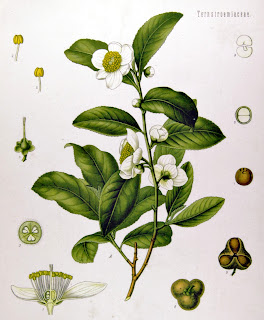“Steampunk is like tea.”
Strictly speaking, tea is an aromatic beverage commonly prepared by pouring hot or boiling water over cured leaves of Camellia sinensis. And like tea, Steampunk also has a common definition, being that it is Victorian Science Fiction, a subgenre that incorporated technology and aesthetic designs inspired by 19th-century industrial steam-powered society.
However, the whole tea definition is far more complex than just being a beverage prepared from the cured leaves of the Camellia bush. Tea is so much more. Firstly there is black tea, oolong tea and green tea. All three are made from the leaves and buds of Camellia sinensis, but the curing processes used to create them vary. Each has a different level of withering and oxidation, with green tea having the least, and black tea the most. But further to that, there are many varieties and blends. For example, the varieties of black tea include:
- Congou (Fujian) - China;
- Lapsang souchong, China;
- Keemun - China;
- Dianhong (Yunnan) - China;
- Yingdehong - China;
- Jiu Qu Hong Mei (Nine Winding Red Plum) - China;
- Sun Moon Lake - Taiwain;
- Assam - India;
- Darjeeling - India;
- Kangra - India;
- Munnar - India;
- Nilgiri - India;
- Jaekseol (Bird's tongue) - Korea;
- Nepali - Nepal;
- Ceylon - Sri Lanka; and
- Rize - Turkey.
As well as varieties, there are hundreds, if not thousands of blends, including:
- Earl Grey - black tea with bergamot oil;
- English Breakfast - full-bodied, robust, rich and blended;
- English Afternoon - medium bodied, bright and refreshing. Strong Assam and Kenyan teas are blended with Ceylon which adds a light, brisk quality to the blend; and
- Irish Breakfast - blend of several black teas: most often Assam teas and, less often, other types of black tea.
And then there is Masala Chai.
Masala chai (literally "mixed-spice tea") originated in Indian subcontinent. It combines black tea, spices native to the Indian sub-continent, milk, and a sweetener such as sugar or honey. Masala chai has been widely recognised and adapted in the West by the locals to their liking since its introduction by the British East India company, with changes in the ingredients and the method of preparation more suited to western consumers. Although traditionally prepared as a decoction of green cardamom pods, cinnamon sticks, ground cloves, ground ginger, and black peppercorn together with black tea leaves, retail versions include tea bags for infusion, instant powdered mixtures, and concentrates.
The term "chai" originated from the Hindustani word "chai", which was derived from the Chinese word for tea, known as "cha". In English, this spiced tea is commonly referred to as masala chai or simply chai. Numerous coffee houses use the term chai latte or chai tea latte (essentially meaning "tea tea latte") for their version to indicate that the steamed milk, much like a regular caffè latte, is mixed with a spiced tea concentrate instead of espresso.
And then there are some teas that are not even tea.
The term herbal tea refers to drinks not made from Camellia sinensis: infusions of fruit, leaves, or other parts of the plant, such as steeps of rosehip, chamomile, or rooibos. These are sometimes called tisanes or herbal infusions to prevent confusion with tea made from the tea plant, but more often than not, people call them “tea”.
Like tea, Steampunk has many varieties and blends.
When it comes to varieties, they are many and varied, and include:
- Victorian - a purer form of Steampunk based on the fashions and style of Victorian England;
- Wild West - also, part of the Victorian Era, but influenced by the fashions and style of the wild west of America;
- Nautical - drawing heavily on “Twenty Thousand Leagues Under the Sea” by Jules Verne, this variety has a strong nautical flavour;
- Colonial - like Wild West, this variety of Steampunk draws on the colonial influences of the Victorian era, be they influences from India, Africa, Asia, or other border regions of the “Empire”;
- Aeronaut - a style influenced by travel in a hot-air balloons, airships, or other flying craft. This variety includes airship pirates, airship crews, krakens and more;
- Apocalyptic/Post Apocalyptic - a style that imagines a less utopic steam powered future (that never was); and
- Many more….
Then, while not strictly Steampunk, there are the other punk genres, all of which fall into the domain of retro-futurism and alternative-futurism. These include:
Futuristic;
- Cyperpunk - a subgenre of science fiction in a future setting that tends to focus on society as "high tech low life" featuring advanced technological and scientific achievements;
- Biopunk - emerged during the 1990s and focuses on the near-future unintended consequences of the biotechnology revolution following the discovery of recombinant DNA;
- Nanopunk - based on a world in which the use of biotechnology is limited or prohibited, and only nanites and nanotechnology is in wide use; and
- Raypunk - (or more commonly "Raygun gothic") is a distinctive (sub)genre which deals with scenarios, technologies, beings or environments, very different from everything that we know or what is possible here on Earth or by science.
Retro-futuristic;
- Steampunk - already discussed;
- Dieselpunk - based on the period roughly spanning the years from 1920 to 1960, dieselpunk draws heavily on World War II and the advent of the diesel engine;
- Decopunk - a subset of Dieselpunk inspired by the Art Deco and Streamline Moderne art styles of the period between the 1920s and 1950s;
- Atompunk (Atomicpunk) - this overlaps Dieselpunk somewhat and relates to the pre-digital period of 1945-1965;
- Clockpunk - this sub-genre portrays Renaissance-era science and technology based on pre-modern designs. Examples of clockpunk include The Blazing World by Margaret Cavendish, Astro-Knights Island in the nonlinear game Poptropica, the Clockwork Mansion level of Dishonored 2, the 2011 film version of The Three Musketeers, as well as the video games Thief: The Dark Project, Syberia and Assassins Creed 2;
- Rococopunk - is a whimsical punk derivative that thrusts punk attitude into the late baroque period. Although it is a fairly recent derivative, it is a style that is visually similar to the New Romantic movement of the 1980s (particularly such groups as Adam and the Ants); and
- Many many more.
Beyond these variations, one blog author (Austin Sirkin, 2013) went as far as to classify individual “types” of Steampunks;
- The Nerf Modders - The folks that love to paint Nerf weapons and use them in their costumes;
- The Material Snobs - those who think that only "real" authentic Victorian materials can be used in the construction of Steampunk props. This includes wood, brass, leather, etc;
- The Definers - people who think that Steampunk, as a movement/genre/whatever, needs to be defined;
- The Undefiners - those who believe that creating a definition of Steampunk will unequivocally be used to exclude people from the community who don't adhere to the guidelines established in a definition;
- SteamJustices - these people preach social justice in Steampunk forums, most often the fire-and-brimstone variety;
- The Privileged - this group is primarily composed of white men and women who see Steampunk as "escapist", and quickly become defensive whenever someone tries to bring so-called "real world" issues into their escapism;
- The Readers - those who read Steampunk literature but don't really do any costuming or prop-making;
- The Writers - people who enjoy writing Steampunk fiction, and believe that their writing enables them to talk about Steampunk with authority, which they frequently do;
- The History Nazi - (similar to the elusive Grammar Nazi) they are convinced that they know a lot about history, regardless of whether that's true or not;
- The Downers - these don't do much of anything but lurk on online forums and say "That isn't Steampunk" whenever someone posts something that arguably isn't Steampunk;
- The Complimenters - the opposite of The Downers. Anytime someone posts a picture of themselves or of something they made, the Complimenters will jump on to say something unhelpful like "Oh, that looks great!" instead of providing any real, useful feedback;
- The Self-Promoters - Not to be confused with event promoters, the Self-Promoters always want to talk about themselves and their work;
- The Characters - (also known as the Personas) these Steampunks enjoy getting into character and pretending to live in a Steampunk world; and
- The Self-Taught - they learned some kind of skill all on their own, either by trial and error, reading books, or watching videos. They are very proud of the skills they've taught themselves, and as a result they refuse to accept criticism from anyone, even from professionals in their field.
Honestly though, I am not sure about you, but if I tried to classify myself using these definitions I am a Self-taught, Reader, Pseudo history nazi, Definer, Material snob, Victorian/colonial Steampunk. You?
So dear reader, as you can see, Steampunk is like tea. It has many varieties, flavours and blends. Some are tea (Steampunk) and others, like the herbal teas aren’t quite “tea”. Some, like masala chai, involve people throwing a whole lot of “other” stuff at tea and make chai, but there is still tea at its core.
With that in mind, does it really matter?
I'm a traditionalist, and I like English Breakfast tea, but do I or should I begrudge others their Earl Grey, or Rose Hip, or even their Chai Latte?
In the end, we should remind ourselves that Steampunk is “Punk”. The punk subculture originated out of working class angst and the frustrations many were feeling about economic inequality and the bourgeois hypocrisy and neglect of working people and their struggles. It was concerned with many concepts, but of them, I think those of primarily concern, and current relevance are;
- Mutual aid
- Egalitarianism
- Humanitarianism
- Anti-authoritarianism
- Anti-consumerism
- Anti-corporatism
- Anti-war
- Anti-racism
- Anti-sexism
- Gender equality
- Racial equality
- Civil rights
- Animal rights
- Disability rights
- Free-thought; and
- Non-conformity.
One of its main tenets was a rejection of mainstream, corporate mass culture and its values.
If you ask me, that sounds like a pretty good set of values doesn’t it? Shouldn’t we therefore be striving to make Steampunk more “Punk”? Let us embrace the varieties, the blends, the differences. Let us make Steampunk and it’s associated communities the most diverse, colourful and inclusive that they can be.
Because, you know what? Sometimes some of us just want coffee…..
(Note: The purpose of The Unorthodox Society for the Elucidation of Retro-Futurism is to elucidate, educate, stimulate positive discussion and enhance the genre. As such, this article is presented to you, the reader, with that intention. Should you not agree with anything written here in, that is your prerogative, but please abstain from making comments that are intended to flame, troll, define, undefine, seek steamjustice or so on. Thank you.)
References:
Austin Sirkin. (2013). 15 Types of Annoying Steampunks. (Online: https://steampunk.wonderhowto.com/forum/15-types-annoying-steampunks-0142496/)Various. (2019). Cyperpunk derivatives. Wikipedia. (Online: https://en.wikipedia.org/wiki/Cyberpunk_derivatives)
Various. (2019). Punk ideologies. Wikipedia. (Online: https://en.wikipedia.org/wiki/Punk_ideologies)




Well I will give the labels I have been calling myself. I will clame Scifi Goth or I sometimes tell people I like parallel dimensions of neo retro utopian Victorianism. I like Victorian clothes, scifi, con culture, and heavy metal... I'm unique... so is everyone else!
ReplyDelete